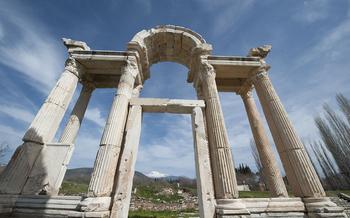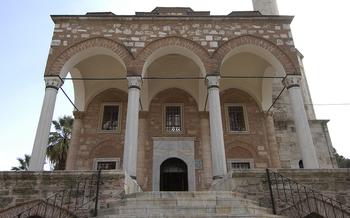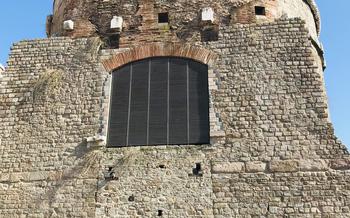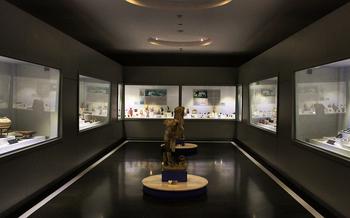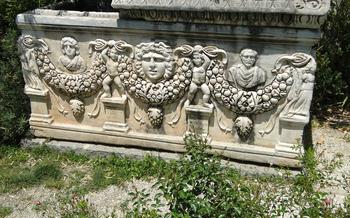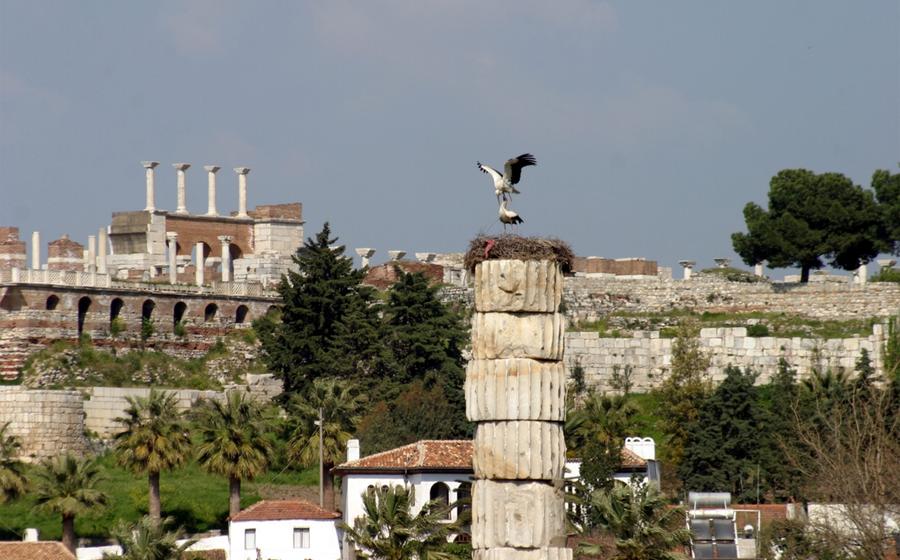
Temple of Artemis
- A Journey Through History: Unveiling the Temple of Artemis
- Tracing the Roots: The Ancient City of Ephesus
- In the Footsteps of Artemis: Exploring the Temple Grounds
- A Symbol of Resilience: The Temple's Enduring Legacy
- A Stroll Through Time: The Ancient City's Surroundings
- Tips for a Memorable Visit: Planning Your Excursion
- Capturing the Essence: Photography at the Temple Site
- Culinary Adventure: Savoring Izmir's Delights
- Unveiling the Human Stories: Archaeological Discoveries
- A Journey Through Time: Transport Options
- Accommodation Options: Finding Your Perfect Stay
- Safety and Security: Ensuring a Peace of Mind
- Insider Tip: Unveiling Hidden Gems
A Journey Through History: Unveiling the Temple of Artemis
A Journey Through History: Unveiling the Temple of Artemis
In the heart of ancient Ephesus, nestled amidst the ruins of a once-thriving city, stands the magnificent Temple of Artemis, a testament to architectural prowess and religious devotion. This awe-inspiring structure, dedicated to the revered goddess Artemis, has stood the test of time, enduring natural disasters, human interventions, and the passage of centuries. Embark on a journey through history as we explore the Temple of Artemis, uncovering its architectural marvels, historical significance, and enduring legacy.
Historical Significance
The Temple of Artemis holds immense historical significance as one of the Seven Wonders of the Ancient World. Its construction dates back to the 6th century BC, a time when Ephesus was a flourishing city and a vital hub of trade and culture. Dedicated to the Greek goddess Artemis, associated with fertility and nature, the temple became a symbol of devotion and a pilgrimage site for worshippers from across the ancient world.
Architectural Marvels
The Temple of Artemis was a marvel of ancient architecture, renowned for its colossal size and intricate design. Constructed using marble and adorned with exquisite sculptures, the temple featured a grand façade adorned with 127 columns, each standing over 60 feet tall. Its interior was equally impressive, boasting a colossal statue of Artemis, crafted from gold and ivory, which attracted pilgrims and visitors from far and wide.
Location and Accessibility
The Temple of Artemis is situated in the ancient city of Ephesus, near the modern Turkish city of Izmir. This coastal region, with its rich cultural heritage and stunning natural beauty, is easily accessible by air and land. Once in Izmir, visitors can conveniently reach the temple site via guided tours or by using public transportation.
Must-See Highlights
When visiting the Temple of Artemis, several highlights should not be missed. Admire the grandeur of the temple's ruins, marvel at the intricate carvings and sculptures that adorn its columns, and envision the colossal statue of Artemis that once stood within. Explore the surrounding archaeological site, where you can wander amidst the ruins of ancient Ephesus, including the Agora, Odeon, and Library of Celsus.
Tracing the Roots: The Ancient City of Ephesus
Ephesus, a city steeped in antiquity, is inextricably linked to the Temple of Artemis. Its history stretches back to the 11th century BC, when it was founded by Androclus, the son of the Athenian king Codrus. The city flourished under Greek rule, becoming a major port and trading center. Its strategic location at the mouth of the Cayster River made it a gateway to the Aegean Sea and beyond.
Ephesus's connection to the Temple of Artemis was profound. The temple was not merely a religious edifice but also a symbol of the city's power and prestige. It attracted pilgrims and visitors from across the ancient world, who came to pay homage to the goddess and marvel at the architectural splendor of her sanctuary.
In addition to the Temple of Artemis, Ephesus is home to a wealth of other notable ruins and landmarks. The city's ancient theater, with a seating capacity of over 25,000, is one of the largest and best-preserved in the world. The Library of Celsus, with its impressive facade and collection of scrolls, was once one of the most renowned libraries in the ancient world. The Agora, the city's central marketplace, was a bustling hub of activity where goods from all corners of the Mediterranean were traded.
Ephesus's significance in the ancient world cannot be overstated. It was one of the largest and most prosperous cities in the Roman Empire, a center of trade, culture, and learning. Its legacy continues to inspire awe and wonder, drawing visitors from around the globe to explore its ruins and experience the echoes of a bygone era.
In the Footsteps of Artemis: Exploring the Temple Grounds
As you step onto the grounds of the Temple of Artemis, prepare to be awestruck by its sheer grandeur. The temple's layout is a testament to ancient architectural prowess, with its rectangular shape and imposing columns that once soared high into the sky. Marvel at the intricate carvings and embellishments that adorned the temple's facade, each one narrating a chapter from the rich history of Ephesus.
Take a closer look at the architectural features that set this temple apart. Notice the intricate Ionic capitals atop the columns, each one a masterpiece of craftsmanship. Admire the fluted columns, their elegant curves creating a sense of rhythm and harmony. Imagine the awe-inspiring sight of the temple's pediments, once adorned with sculptures depicting tales from Greek mythology.
Among the ruins, discover the remains of the temple's altar, where offerings were made to the goddess Artemis. Envision the smoke rising from the sacrificial fires, as ancient worshippers sought the favor of their deity. Nearby, you may stumble upon fragments of pottery, coins, and other artifacts that have been unearthed during excavations, offering glimpses into the rituals and practices that took place within the temple's sacred walls.
A Symbol of Resilience: The Temple's Enduring Legacy
Over the centuries, the Temple of Artemis has withstood the relentless passage of time and a series of catastrophic events. Despite being destroyed and rebuilt several times, its enduring legacy remains a testament to the resilience of human spirit and the enduring power of ancient architecture.
Natural disasters, particularly earthquakes, have been a recurring threat to the temple's existence. In the 4th century BC, a devastating earthquake caused significant damage, leading to the temple's partial collapse. However, the Ephesians, determined to preserve their sacred site, embarked on an ambitious reconstruction project, restoring the temple to its former glory.
Human intervention has also played a role in the temple's tumultuous history. In the 1st century AD, a mob led by the early Christian bishop John the Apostle set fire to the temple, causing extensive damage. This act marked the beginning of the temple's decline, as Christianity gradually replaced the ancient pagan beliefs.
Despite these challenges, the Temple of Artemis has managed to endure, albeit in a fragmentary state. In the 19th century, extensive excavations were conducted by British archaeologists, revealing the temple's foundations and unearthing numerous artifacts. These discoveries have provided invaluable insights into the temple's construction, design, and religious significance.
Today, the Temple of Artemis stands as a symbol of resilience, reminding us of the enduring power of ancient civilizations and the human spirit's ability to overcome adversity. Its ruins serve as a testament to the ingenuity and artistry of the ancient Greeks, and continue to inspire awe and wonder in visitors from around the world.
A Stroll Through Time: The Ancient City's Surroundings
Beyond the Temple of Artemis, the ancient city of Ephesus offers a wealth of other ruins and landmarks that transport visitors back in time. A short walk from the temple, the Agora, once the bustling marketplace, invites exploration with its well-preserved columns and storefronts. The nearby Odeon, a small theater, hosted musical performances and public gatherings, while the magnificent Library of Celsus, with its impressive facade and two-story design, served as a repository of knowledge and learning.
These structures, remnants of a once-thriving metropolis, provide a glimpse into the daily life and cultural pursuits of the ancient Ephesians. As you wander among the ruins, imagine the city's bustling streets, the sounds of trade and conversation filling the air, and the intellectual discourse taking place within the library's walls. Ephesus was a city where commerce, entertainment, and scholarship flourished, leaving behind a legacy that continues to captivate visitors to this day.
Tips for a Memorable Visit: Planning Your Excursion
To make the most of your visit to the Temple of Artemis, careful planning is essential. The best time to visit is during the shoulder seasons (April-May and September-October) when the weather is pleasant, and the crowds are smaller. Summer months can be hot and crowded, while winter can be cold and rainy.
Appropriate attire is crucial, as the temple site involves a lot of walking on uneven surfaces. Comfortable shoes, loose-fitting clothing, and a hat to protect yourself from the sun are recommended.
Guided tours are available for those who prefer a more in-depth understanding of the temple's history and significance. However, self-guided exploration is also an option for those who prefer to wander at their own pace.
Remember to bring essentials like water, sunscreen, and a camera to capture the temple's grandeur. A flashlight can also be helpful for exploring the darker corners of the ruins.
Capturing the Essence: Photography at the Temple Site
The Temple of Artemis, with its iconic columns and impressive architectural details, presents a captivating subject for photography enthusiasts. To capture the temple's grandeur, consider arriving early in the morning or late in the afternoon, when the golden light casts a warm glow on the ruins. Experiment with different angles and perspectives to create dynamic compositions. Remember to respect the site's significance and avoid using tripods or flash photography that may disrupt other visitors' experiences.
Culinary Adventure: Savoring Izmir's Delights
A journey to Izmir is not complete without tantalizing your taste buds with the city's culinary offerings. Izmir's cuisine is a vibrant tapestry of flavors, influenced by its rich history and diverse cultural heritage. From traditional Turkish dishes to modern fusion creations, the city's culinary scene is sure to delight every palate.
Indulge in the delectable local specialty, kumru, a toasted sandwich filled with tangy tulum cheese, juicy tomatoes, and crispy lettuce. For a taste of traditional Turkish cuisine, savor the aromatic sarma, tender grape leaves stuffed with rice, herbs, and minced meat. Unleash your inner foodie at Kemeraltı Çarşısı, the city's bustling bazaar, where you can savor an array of street food delicacies, from freshly grilled kebabs to sweet Turkish delights.
For a fine dining experience, head to one of Izmir's many acclaimed restaurants. Sample the innovative creations of world-renowned chefs, showcasing the region's freshest ingredients with a contemporary twist. Don't miss the opportunity to relish the world-famous Izmir figs, renowned for their exceptional sweetness and flavor.
Unveiling the rich culinary heritage of Izmir is an adventure in itself. Food here is not just sustenance; it's a celebration of life, culture, and community. Embark on a culinary journey through Izmir's vibrant streets, markets, and restaurants, and discover the true essence of this enchanting city.
Unveiling the Human Stories: Archaeological Discoveries
The Temple of Artemis, with its rich history and archaeological significance, has witnessed numerous excavations and discoveries that have shed light on the human stories connected to this sacred site. Through these discoveries, we can glimpse into the lives of individuals and communities whose paths intertwined with the temple.
Archaeological excavations at the site have unearthed a wealth of artifacts, including pottery, coins, jewelry, and religious objects, providing valuable insights into the daily lives and rituals of the ancient Ephesians. These artifacts offer a tangible connection to the people who once worshipped at the temple, allowing us to envision their hopes, fears, and aspirations.
Among the most intriguing discoveries are the inscriptions and dedications left by visitors and pilgrims who came to pay homage to Artemis. These inscriptions reveal the personal stories of individuals who sought divine favor, expressed their gratitude for answered prayers, or simply left their mark on this sacred place.
The excavations have also uncovered evidence of the temple's role as a center of healing and refuge. Votive offerings in the form of body parts, such as eyes, ears, and hands, suggest that people came to the temple seeking cures for their ailments. The presence of a hospital within the temple complex further supports this notion, highlighting the temple's multifaceted role in ancient society.
By piecing together these archaeological fragments, we can begin to reconstruct the human stories that unfolded within the walls of the Temple of Artemis. These stories remind us that behind the grand architecture and historical significance lies a tapestry of human experiences, emotions, and beliefs that continue to resonate across the centuries.
A Journey Through Time: Transport Options
Reaching the Temple of Artemis and the Enchanting City of Izmir
Embarking on your journey to the Temple of Artemis requires seamless transportation. Whether you're arriving by air, land, or sea, various options await to transport you to this ancient marvel.
By Air:
- Izmir Adnan Menderes Airport (ADB): The closest airport, located approximately 18 kilometers from the city center, offers domestic and international flights. From the airport, you can take a taxi, rent a car, or hop on the Havaş shuttle bus to reach your destination.
By Land:
-
Intercity Buses: Izmir is well-connected by an extensive network of bus routes. Buses depart from various cities across Turkey, providing a budget-friendly and convenient way to reach Izmir.
-
Trains: The Turkish State Railways (TCDD) operates train services connecting Izmir to major cities like Istanbul, Ankara, and Konya. Trains offer a scenic and comfortable journey, allowing you to admire the picturesque Turkish countryside.
By Sea:
- Ferries: If you're arriving from neighboring Greek islands like Chios or Samos, ferries offer a delightful way to reach Izmir. The journey by sea provides stunning views of the Aegean coastline and the vibrant port city.
Navigating the Transportation System:
Once in Izmir, navigating the transportation system is a breeze. The city's public transportation network, including buses and trams, is efficient and affordable. Taxis are readily available and relatively inexpensive. For a more independent exploration, consider renting a car, which allows you to explore the city and its surroundings at your own pace.
Tips for a Smooth Journey:
-
Book your flights or train tickets in advance, especially during peak tourist season, to secure the best rates and availability.
-
If renting a car, familiarize yourself with Turkish traffic regulations and consider purchasing additional insurance for peace of mind.
-
Validate your public transportation tickets upon boarding buses or trams to avoid fines.
-
Learn a few basic Turkish phrases to communicate with locals and navigate the transportation system more easily.
Accommodation Options: Finding Your Perfect Stay
When planning your trip to explore the Temple of Artemis and the ancient city of Ephesus, finding the right accommodation is essential. Izmir offers a wide range of options to suit every traveler's preferences and budget.
For a truly immersive experience, consider staying in one of the charming guesthouses or boutique hotels located within the historical center of Izmir. These accommodations often occupy restored Ottoman-era buildings, providing a unique blend of history and modern comfort.
If you prefer the convenience of a larger hotel, several international chains and local establishments offer comfortable stays within easy reach of the temple site. Look for hotels in the Alsancak, Konak, or Karsiyaka districts, which are well-connected by public transportation and offer a variety of dining and shopping options.
For those seeking a more budget-friendly option, there are several hostels and guesthouses catering to backpackers and budget travelers. These accommodations often provide dormitory-style rooms or shared apartments, offering a chance to meet fellow travelers and keep costs low.
When choosing your accommodation, consider factors such as proximity to the temple site, your budget, and desired level of comfort. Whether you opt for a historic guesthouse, a modern hotel, or a cozy hostel, Izmir has something to offer every traveler.
To make the most of your stay, book your accommodation in advance, especially if you're visiting during the peak tourist season. This will ensure you secure a comfortable place to rest and recharge after a day of exploring the ancient wonders of Ephesus and the Temple of Artemis.
Safety and Security: Ensuring a Peace of Mind
Ensuring a safe and enjoyable travel experience is of paramount importance when visiting any destination. The Temple of Artemis and its surrounding areas are generally considered safe for tourists. However, as with any travel destination, it's essential to exercise caution and be aware of your surroundings.
The temple site is well-maintained, and security measures are in place to ensure the safety of visitors. However, petty theft can occur, so it's advisable to keep your valuables secure and be vigilant.
When exploring Izmir, it's recommended to dress modestly and respectfully, especially when visiting religious or conservative areas. It's also advisable to avoid walking alone at night, especially in poorly lit areas.
Be sure to follow local customs and traditions to avoid any misunderstandings or offense. Respecting the local culture will help you have a more positive and enjoyable experience.
In case of any emergencies, dial 112, the universal emergency number in Turkey, for assistance.
Insider Tip: Unveiling Hidden Gems
While the Temple of Artemis and the surrounding ruins are undoubtedly captivating, Izmir and its vicinity offer a treasure trove of hidden gems waiting to be discovered. Venture beyond the main tourist trail to uncover lesser-known attractions that provide a glimpse into the city's rich history and culture.
Seek out the neighboring ancient city of Klazomenai, located just a short distance from the Temple of Artemis. Explore its ruins, including the impressive city walls, and immerse yourself in the stories of this once-thriving port city.
For breathtaking views of the region, climb up to the summit of Mount Pion. This scenic spot offers panoramic vistas of the Gulf of Izmir, the surrounding countryside, and the distant Temple of Artemis. Capture stunning photographs and revel in the tranquility of this natural haven.
Uncover the culinary secrets of Izmir by venturing into the local markets and food stalls. Indulge in traditional Turkish delights such as gözleme (savory stuffed flatbread), keşkek (a hearty wheat and meat dish), and the famous İzmir köfte (meatballs). Engage with local vendors and discover the stories behind these culinary treasures.
Embark on a boat trip to explore the picturesque coastline of the Gulf of Izmir. Visit secluded coves, swim in crystal-clear waters, and admire the stunning scenery from a unique perspective. Discover hidden beaches and experience the tranquility of the Aegean Sea.
These hidden gems offer a unique and authentic Izmir experience. Step off the beaten path, embrace the unexpected, and create lasting memories in this vibrant and captivating city.
